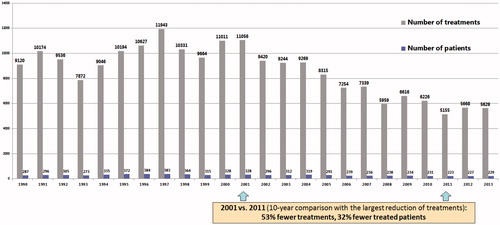For decades phototherapy was an effective and relatively safe mainstay of treatment for various dermatological diseases, particularly highly prevalent inflammatory dermatoses such as psoriasis, atopic dermatitis or chronic hand eczema. Despite the prevailing opinion of a declining role of phototherapy, there are hardly any data published showing the reduced use in concrete numbers (Citation1–4). In that context, we consider the publication of Luersen et al. as remarkable. The key messages of their publication are –the use of phototherapy in the United States has remained low from 1997 to 2008, but was considerably increased in 2009/10 partly for growing use in non-psoriasis dermatologic diseases. Unfavorable economic incentives have been mentioned as a major reason (among others such as new treatment options and inconvenience) for the initial declined use of phototherapy during the 1990s (Citation1,Citation2). In Switzerland phototherapy is covered by the public basic health insurance and is still profitable for dermatological institutions and practising dermatologists. In consequence, the negative effect of the financial issues concerning the use of phototherapy might not be true for Switzerland.
Nonetheless, the number of phototherapy treatments (including UVB 311 nm and broad band, UVA, local/systemic PUVA of in- and outpatients including children) in our dermatology university clinic declined gradually since the new millennium, as shown in . The 10-year comparison with the largest reduction of treatments was between 2001 and 2011. While the number of treatments in that decade was reduced by 53% (11 059 vs. 5 155), the reduction of the treated patients was only by 32%. This indicates that not only less patients were treated, but the treatment duration was also shorter. This particular point might be partly explained by fewer indications for long-term phototherapy (patients with severe psoriasis will receive a biologic) and more effective modalities (UVB 311, UVA1), but might also reflect a more reluctant use because of potential long-term risks such as photocarcinogenesis and photoaging. This reluctance was not addressed by Luersen et al., but it might be another main reason for the declining importance of phototherapy in the last two decades.
Figure 1. Annual numbers of treatments with phototherapy and patients treated with phototherapy between 1990 and 2013.

Phototherapy – less effective compared to biologics, unprofitable, old-fashioned and hazardous? These negative connotations make future perspectives dark. However, they are slightly brightened by some aspects. One was shown by Luersen et al.: phototherapy may recover some lost ground when used more for conditions other than psoriasis (e.g. vitiligo, novel indications for UVA1). Moreover, some authors highlight, that there is a misconception, that phototherapy does not work as well as biologics do in psoriasis (Citation5,Citation6). In the entire medical literature, there are only two treatments where 100% of the patients achieved a PASI 75 response after 12 weeks, and both of those treatments were phototherapies (combination of retinoids plus PUVA and Goeckerman treatment (combination of coal tar plus UVB)) (Citation6). Whereas biologics are by far more practicable, phototherapy is considered to be safer given the experience of 5 decades of clinical utilization and to have socio-economic advantages compared to biologics (Citation5). Finally, some patients prefer “natural” phototherapy to “chemicals” and therefore reject treatment with a biologic. Taking into consideration these aspects, phototherapy remains an important treatment modality in psoriasis as well.
References
- Luersen K, Dabade TS, West CE, et al. Phototherapy trends in dermatology. J Dermatolog Treat. 2014;25:487–8
- Housman TS, Rohrback JM, Fleischer AB Jr, Feldman SR. Phototherapy utilization for psoriasis is declining in the United States. J Am Acad Dermatol 2002;46:557–9
- Bowers J. Monthly Archives American Academy of Dermatology Association; 2012. Available from http://www.aad.org/dw/monthly/2012/psoriasis/what-happened-to-phototherapy. Accessed September 26, 2014
- Lapolla W, Yentzer BA, Bagel J, et al. A review of phototherapy protocols for psoriasis treatment. J Am Acad Dermatol 2011;64:936–49
- Lehmann P. Phototherapy in the era of biologicals. Hautarzt 2013;64:345–8
- Leon A, Nguyen A, Letsinger J, Koo J. An attempt to formulate an evidence-based strategy in the management of moderate-to-severe psoriasis: a review of the efficacy and safety of biologics and prebiologic options. Expert Opin Pharmacother 2007;8:617–32

